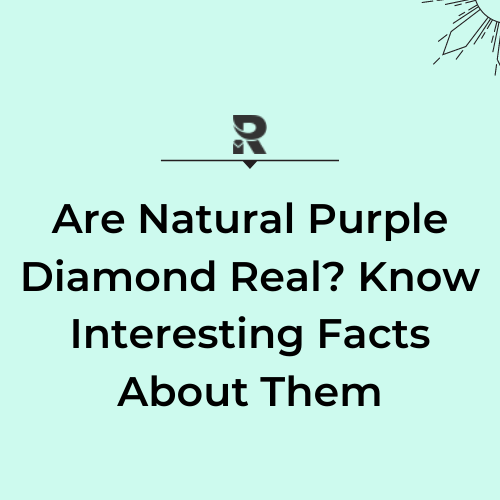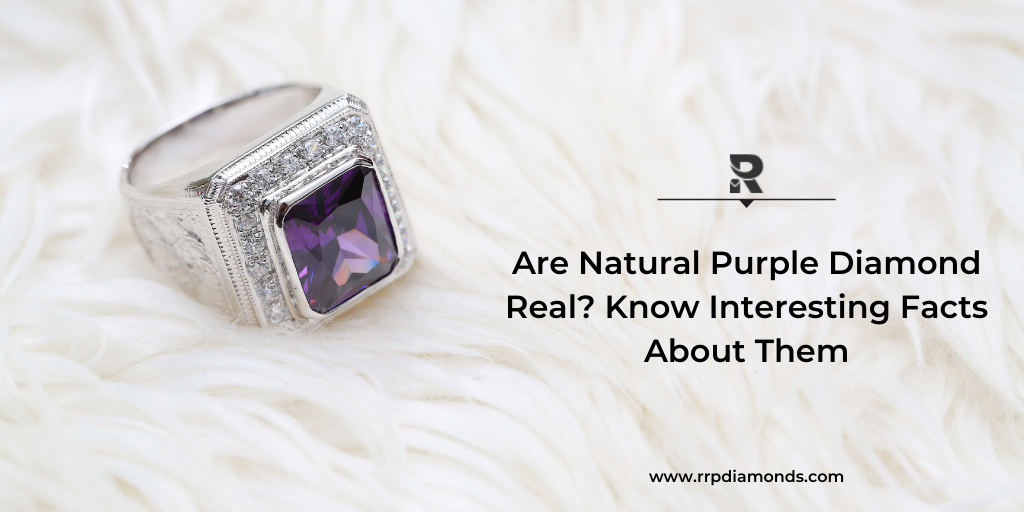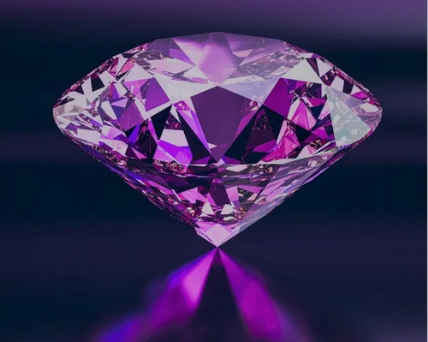
Purple diamonds are classified as fancy diamonds, they are the next rare species after pink and red fancy diamonds. These darker-hued diamonds are commonly referred to as grape diamonds, orchid, or plum diamonds. And the lighter ones are called lilac or mauve.

Let us help you get more information on purple diamonds.
ORIGIN OF PURPLE DIAMONDS
Their origin is specific to geographic locations. According to statistics nearly 100% of natural colored purple diamonds are found in mines located in Canada, Australia, and Russia.
In other locations, only 1% are purple diamonds of which all the diamonds are mined from Siberia, Canada, and Australia.
Smaller mines where purple diamonds are mined are in Yakutia and Arkhangelsk. Smaller violet-colored diamonds are found only in The Argyle Mines of Australia, which are going to close this year, Increasing the demand and popularity of violet diamonds incrementally. These diamonds are also responsible for the production of pink-colored diamonds.
However, these diamonds are so rare that only about 100ct have been mined till this date and only 12ct of violet diamonds have been mined in the past 32 years.
With their decreasing numbers, their demand has been on the rise. Thus, their prices and sales have nearly doubled within the past two years.
Purple diamonds, especially lavender, iliac, lavender, and plum have become notoriously popular among collectors and investors, ranking the purple diamonds as the top three most popular gemstones.
HOW DO PURPLE DIAMONDS GET THEIR COLOR?
The source of the color of purple diamonds is well disputed among many gemologists. Despite all the debate on the topic, there have been some common conclusions:
- For violet diamonds, some of them contain boron, which imparts a blue color to the diamonds. It is common knowledge that the purple color is a combination of red and blue. The GIA grades the fancy purple color diamonds by distinguishing between reddish tone purple diamonds and bluish violet diamonds. Hence purple is regarded as more valuable than violet.
- Some diamonds have trace amounts of hydrogen as well.
- While others have structural anomalies in their crystalline structure caused due to interactions between different elements.
- Some argue that purple diamonds undergo a huge amount of pressure endured during their formation, which may be the reason for their color.
- Otherwise today even lab-grown and treated purple diamonds are sold in the market, however, their success rate is not so high. But it is the most preferred option for someone who finds the purple diamond less affordable and too rare.
COLOR GRADES OF THE PURPLE DIAMOND
The GIA has a separate color grading scale for these fancy diamonds and purple diamonds are required to follow the same grading system. The color grade increases according to its intensity and saturation level.
The GIA grading scale:
- Faint
- Very Light
- Light
- Fancy Light
- Fancy
- Fancy Intense
- Fancy vivid, Fancy Deep, and Fancy dark.
Even purple diamonds contain a secondary color tone or an overtone of pink or gray. Some of them come with red or brown overtones.
Also read: Why Are Pink Diamond So Rare And Exclusive?
Normally any secondary color in a fancy diamond diminishes its value, however, that is not the case for a purplish pink stone, as a matter of fact, it is valued just as much as a pink diamond. Diamonds that have undergone color enhancements often have a higher saturation rate and display an orange fluorescence.
THE RARITY AND VALUE OF PURPLE DIAMONDS
The rarity of purple diamonds may not match with those of red diamonds, or pink diamonds. They are nonetheless still rare! Purple diamonds, however, are more difficult to come by with a high purity grade. Most of these precious gems have secondary overtones.
When it comes to its pricing Purple diamonds with a secondary overtone, or a modified purple, are unquestionably less expensive than pure purple diamonds, as they are less rare too.
For example, a 0.42ct Fancy pink-purple diamond with a round cut costs nearly $15,210 compared to a 0.40ct Fancy deep pinkish-purple diamond with a cushion-cut which costs around $38,000.
Despite how rare “pure” fancy diamonds are you can always expect to find one at the best diamond retailers and auctioneers. Their prices however are expected to be higher compared to other retailers, as they sell only the highest quality of certified fancy diamonds.
HOW CAN YOU JUDGE THE QUALITY OF A PURPLE DIAMOND?

When it comes to buying any diamond, it is paramount that you purchase one of the highest qualities for the price that you offer, however sometimes people tend to compromise on the quality to accommodate the budget. It is best recommended to not do so for fancy diamonds. Hence the quality is paramount.
The most important factor is the intensity of the color of the diamond. It is not only one of the price-determining factors of a fancy diamond, but the other factors are best chosen to compliment the primary factor.
Diamonds graded Fancy Intense and Fancy vivid have the highest saturation and hence are the most intense. These types of diamonds also do have the highest price per carat.
If the color intensity personally is of no concern to you then you can opt for the fancy light color grade as there is a significant increase in price per carat from fancy light to fancy dark colors.
If you are someone who prefers a darker intensity for diamond color, you can go for violet-colored diamonds as they are significantly deeper and darker tones compared to purple diamonds which have a pastel tone.
Since diamonds tend to have a secondary tone, there are price fluctuations that can be noticed even with the slight change in the color or hue of a fancy diamond. And this applies to almost all diamonds that are certified by the GIA.
They are the most trusted in the market and they have graded about every fancy diamond sold. The GIA tends to use an adjective whenever a secondary overtone is found and a noun for the primary color in a fancy diamond.
For example, a diamond that is pinkish purple in color would have a secondary tone of pink and the primary color would be purple. On the other hand, a purple-pink color would have a more notable pink shade.
LAB GROWN PURPLE DIAMONDS
A GIA certification also comes in handy if you are trying to differentiate between lab-grown diamonds and naturally mined diamonds. With the growing popularity of lab grown diamonds, one can never be too careful.
INCLUSIONS ON PURPLE DIAMONDS
Another thing to bear in mind is the inclusions on the stone. A purer diamond or one with intense color is bound to have some inclusion but paler diamonds have a greater clarity grade. Inclusions play a greater role when it comes to selecting a cut for your diamond. A cut style with point ends with inclusions may cause the stone to chip off easily.
AESTHETICS OF THE PURPLE DIAMOND
Some of the cuts which are popularly chosen for fancy diamonds are the oval cuts, cushion, radiant, pear-shaped, or emerald cuts. As you can notice most of these cuts come with a tapered end and enhance the brilliance of the purple diamond. Diamond cutters do their best to give the stone deeper proportions and a thick girdle.
The metal you choose can also impact the appearance of the diamond. It may cause it to become dull or brighter than its actual grades. Rose gold settings are most recommended for a purple diamond with a high-intensity grade. On a halo setting with colorless diamonds, you can set the diamond as the center gem to get the best contrasting effect.
The things you need to check while purchasing a purple diamond,
- The origin – has to be natural and not lab synthesized
- The color grade – In the fancy range
- The clarity grade – the SI1 grade is most preferred
- Symmetry – good to excellent
- Fluorescence – None to Faint
- Polish – Good to Excellent
ENGAGEMENT RING SETTINGS FOR PURPLE DIAMONDS
A purple diamond ring is bound to turn heads regardless of whatever situation you are in. Some of the most elegant ring style that compliment a purple diamond are as follows:
- THE SIDE STONE SETTING
It may be a ring setting that would cost you a few dollars more than other ring settings. But smaller stones will offer a greater carat weight and a unique style for your purple diamond. This setting is mostly preferred for those who are big on engagement rings having large carat weight. As you can only too far with just purple diamonds.
- PAVE SETTING
This setting too involves smaller diamonds encrusted on the lining of the band, it adds brilliance to the ring, and with the right cut, it can enhance the appearance of your ring.
- HALO SETTING
The halo setting is perhaps the most preferred when it comes to fancy diamonds or diamonds with large carat weights. This setting not only increases the surface area of your ring but also elevates it and highlights the brilliance of the purple stone, making it a definite eye-turner.
Also read: Tips For Beginners Diamond Trader-How To Get Started
Conclusion Thoughts
The purple diamonds are classified as fancy diamonds, they are the next in line according to rarity after red, purple, and blue colored diamonds. Since they are so difficult to procure naturally, lab-grown purple diamonds are also available on the market at a lesser price.
However, they do not gain the attention of investors or collectors. Over the years the rapid decline of fancy-colored diamonds has helped them to gain popularity among the public and hence has become the primary reason for the incremental increase in their price per carat.
Purple diamond rings are a perfect choice for an engagement ring, a halo setting with a rose gold metal, complemented with colorless diamonds is the most recommended setting.